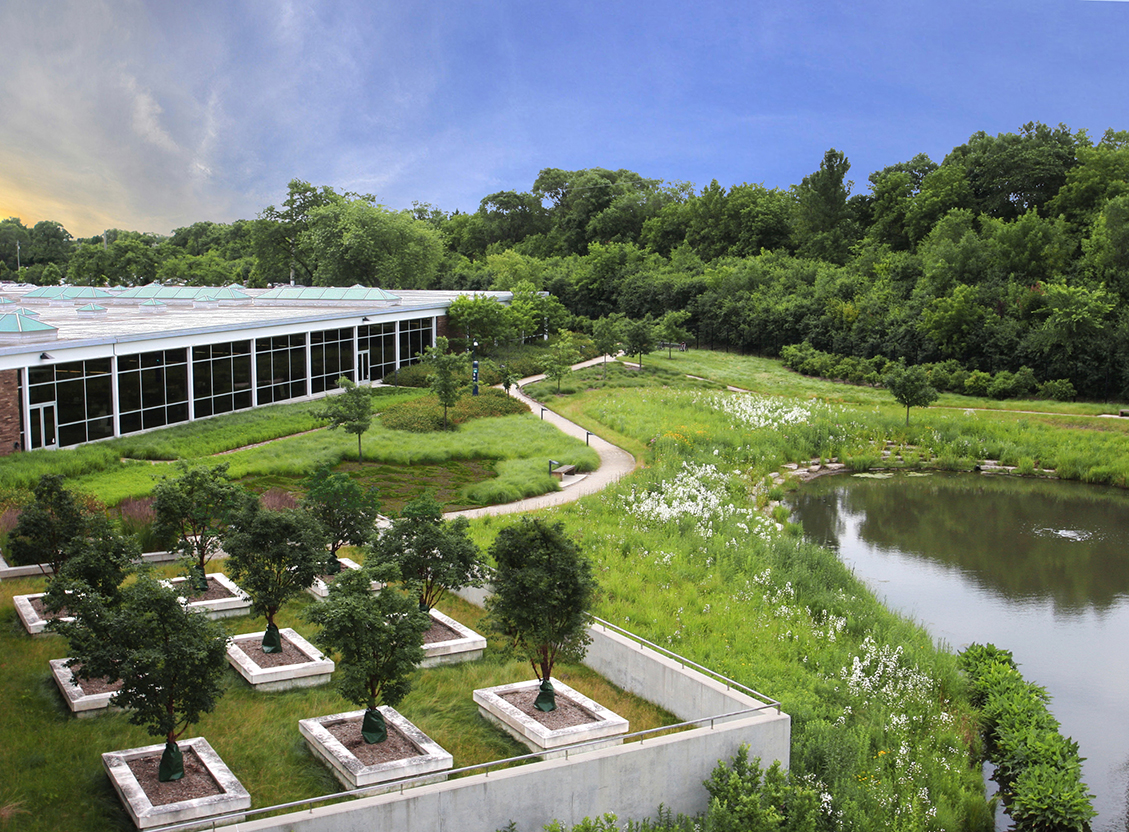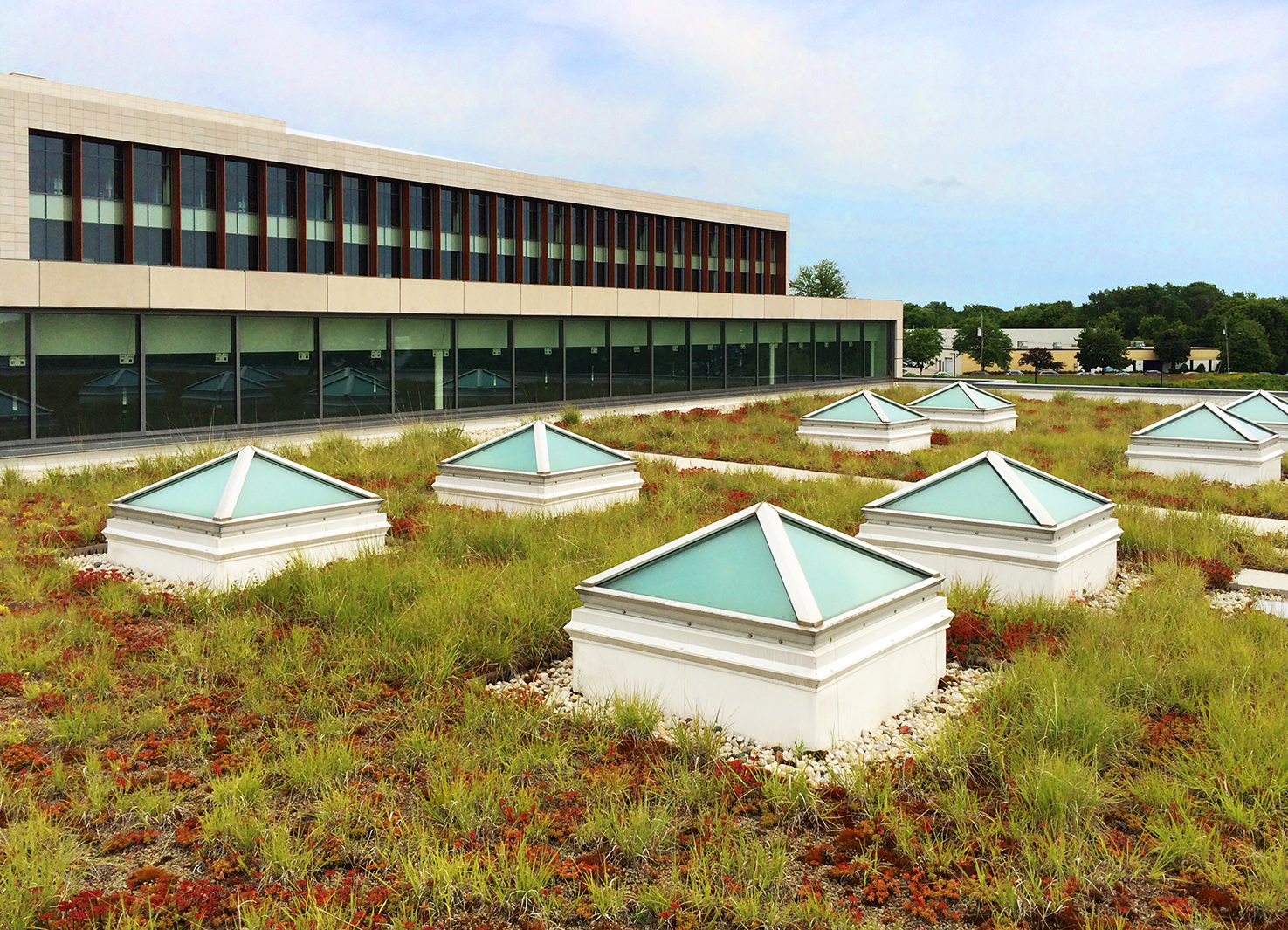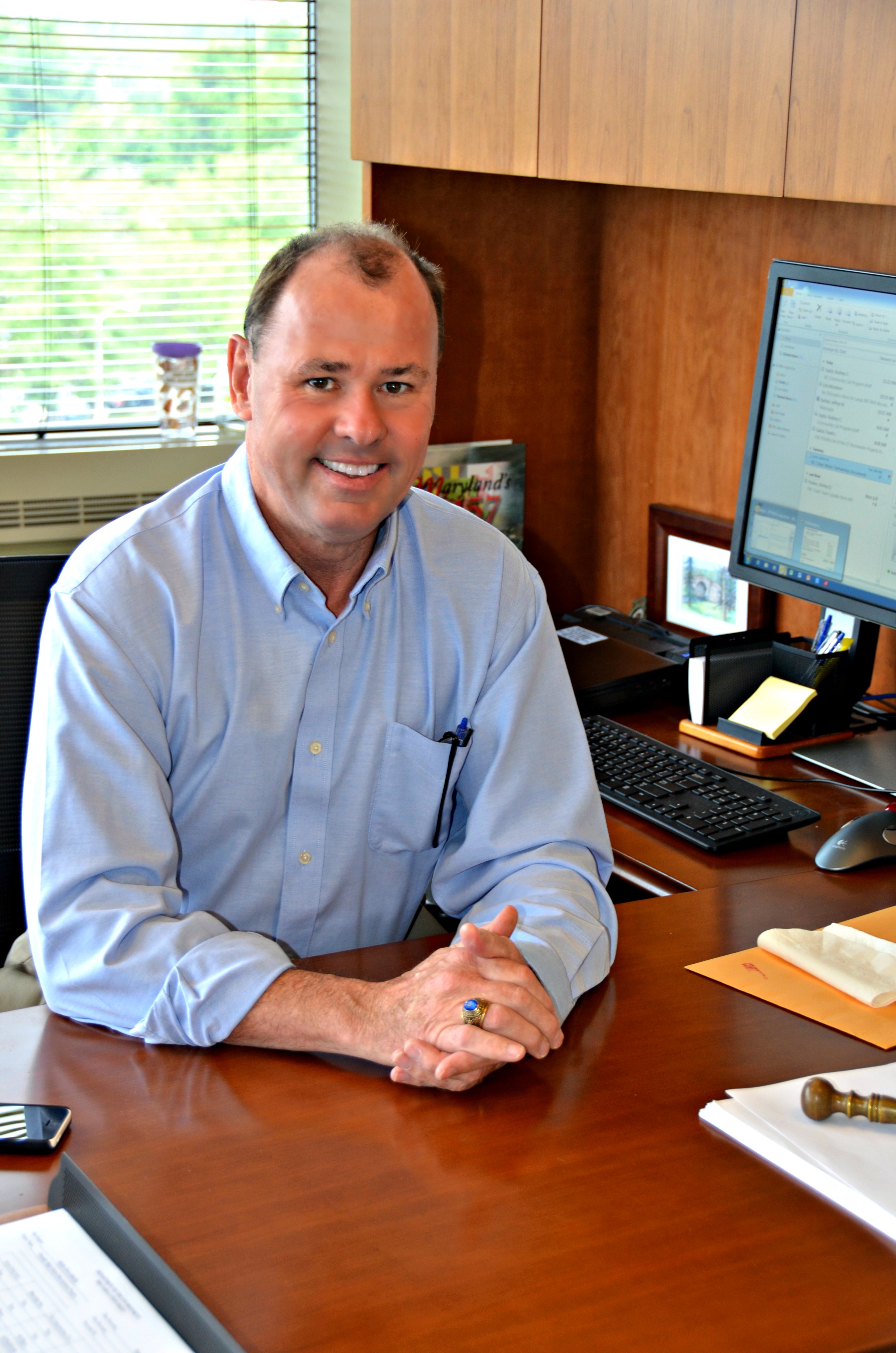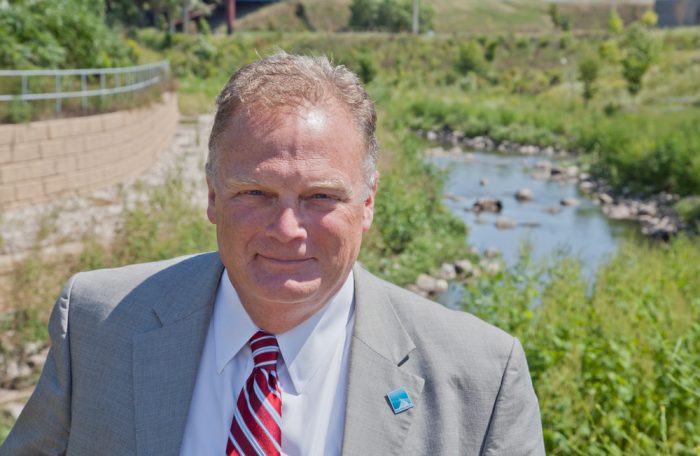SPECIAL REPORT:
New approaches to large-scale green stormwater infrastructure investment build climate resilienceby Issue Media Group
 This naturalized detention is an example of green stormwater infrastructure at corporate headquarters of Johnson Controls, Inc. in Glendale, Wisconsin
This naturalized detention is an example of green stormwater infrastructure at corporate headquarters of Johnson Controls, Inc. in Glendale, Wisconsin
More frequent and intense rainstorms. Elevated heat and humidity. High water levels and increased shoreline erosion. The realities of climate change, combined with aging and outmoded stormwater infrastructure, create a crisis for Great Lakes stormwater managers.
The good news is many of these challenges can be mitigated through the construction of green stormwater infrastructure–constructed wetlands, porous concrete, and bioswales that help treat stormwater and take the pressure off traditional gray infrastructure like sewers, pipes, pumps, and tunnels. But communities are challenged to fund and implement projects at the scale needed to address the crisis.
Fortunately, new thinking and approaches to funding and constructing green stormwater infrastructure are emerging. These methods, which combine market principles with community benefits, are upending the traditional economics and practice of building green stormwater infrastructure and are bringing climate resilience within reach.
These innovative concepts are increasingly taking hold in the Great Lakes region. The most notable example is in the Milwaukee area, where the Milwaukee Metropolitan Sewerage District (MMSD) recently issued a Request for Proposals (RFP) for an ambitious new public-private partnership (P3) related to the large-scale use of green stormwater infrastructure. The MMSD is a regional wastewater utility with a 411-square-mile service area serving 1.1 million people, and it has established a reputation as a national leader in sewage management.
MMSD has reduced its sewer overflows from 50-60 per year in the early 1990s to just 2.3 per year today, and has established ambitious goals for the future that include zero overflows by 2035. In that same timeframe, it also aims to capture the first half-inch of rainfall on all impervious surfaces, the equivalent of 740 million gallons of stormwater.
And its most recently issued stormwater permit sets a goal of establishing 50 million gallons’ worth of green stormwater infrastructure capacity within five years. “That’s not being driven by a lawsuit or by poor financials,” says MMSD executive director Kevin Shafer. “It’s being driven by an understanding that if we’re ever going to get ahead of these larger storms and if we’re ever going to see the environment restored to what it was 40 or 50 years ago, we need to do something different than what we’ve been doing.”
MMSD’s planned P3, known as Community Based Green Infrastructure (CBGI), is key to achieving those goals. The district has done P3s to construct green stormwater infrastructure in the past, but those have been structured on a project-by-project basis. The CBGI RFP seeks a single partner to create a minimum of 20 million gallons of green infrastructure-based stormwater capture capacity within three years. It also expects a reduction of capture costs below its current cost of $1.76 per gallon, and to engage at least 25% small and veteran-, women-, and minority-owned businesses.
Sanjiv Sinha, Ph.D., is a vice-president with Ann Arbor-based consulting firm Environmental Consulting & Technology, Inc. (ECT). With funding from the Great Lakes Protection Fund (GLPF), Sinha is pioneering the application of market-based business concepts to the infrastructure sector and worked extensively on analyzing market-based options for MMSD. His team recommended a community-based P3 (CBP3) for MMSD.
 Sanjiv Sinha, Ph.D., Vice President, Environmental Consulting & Technology, Inc.
Sanjiv Sinha, Ph.D., Vice President, Environmental Consulting & Technology, Inc.
“You are looking at basically a single RFP where they’re trying to construct green stormwater infrastructure projects that would otherwise cost nearly $35 million to capture,” Sinha says. “That scale is very impressive. And if you know MMSD’s history and Shafer’s leadership, not surprising.”
Karen Sands, director of planning, research, and sustainability for MMSD, notes that the RFP establishes a four-phase process for the CBGI that allows MMSD “offramps” if it doesn’t find the right partner off the bat. The phases are visioning; preliminary engineering/design and financial plan development; engineering services during construction; and post-construction vegetation establishment and long-term strategy. MMSD is currently planning to issue a contract only for the first phase, with additional contracts to be issued at its discretion.
Sands says MMSD staff “kept taking things out” of the RFP as they assembled it, creating an intentionally open-ended framework that allows for the development of a new model in collaboration with the private partner.
“We think we’re inventing a new model and we look forward to talking with the firms or group of firms that we ultimately select about how this works because I don’t think it’s been done this way before,” she says. “We want to take our time and make sure that we get it right.”
Sinha’s funder GLPF agrees with that approach.
“GLPF seeks to fund projects that are highly innovative and typically ten years ahead of their time,” says GLPF vice president Steve Cole. “We find that flexibility is key to the adoption of a new approach by a community.”
Aside from their work in Wisconsin, Sinha’s team is working on initiating two other transactions–in the states of New York and Ohio–that could amount to an additional $38 million in investments in green stormwater infrastructure in the Great Lakes. Unlike for MMSD, these transactions focus on private financing. In their entirety, Sinha’s team’s work in Wisconsin, New York, and Ohio represents an emerging shift in the stormwater market that typically relies on government funding and procurement processes that are well over a century old.
 This green roof is an example of green stormwater infrastructure at corporate headquarters of Johnson Controls, Inc. in Glendale, Wisconsin
This green roof is an example of green stormwater infrastructure at corporate headquarters of Johnson Controls, Inc. in Glendale, Wisconsin
The evolution of public-private partnership projects for stormwater
MMSD’s cutting edge work leans on a model already in place in Prince George’s County in Maryland. In 2014, Prince George’s County, Md., also had a major environmental challenge on its hands. The county was under a permit requirement from the Maryland Department of the Environment to treat polluted stormwater runoff from 6,105 acres by 2019. County leaders knew that achieving such a large-scale impact would require some new thinking.
That opportunity came in the form of the Clean Water Partnership (CWP), a community-based private-public partnership (CBP3) between Prince George’s County and Rhode Island-based company Corvias. In CWP’s initial three-year pilot phase, which concluded in 2018,
Corvias was tasked with creating 2,000 acres of green stormwater infrastructure. Corvias not only exceeded that goal by over 100 acres, but it also created a $183 million economic impact for the county at a cost of $100 million. The firm allocated 87% of its expenditures to minority-owned businesses located within the county or owned by county residents. And it did all of this under-budget.
Building on this resounding success, the CWP began its second phase in late 2018, this time with the county investing $110 million in the project. Greg Cannito, a partnership innovator for Corvias, says the firm is now in conversations with the county about the third phase for CWP. “We were able to drive the implementation costs down by 40% on average per acre,” Cannito says.
“We were able to deliver faster. We were able to work and integrate well with the county’s teams. We were able to get good buy-in and involvement from the community on their acceptance of the program. And we were able to exceed our performance metrics for driving local economic development returns for the community. So the county wanted to invest more in the program for continued value creation.”
Filling a massive national need while lowering the cost of delivery
CWP is a prime example of how innovative partnerships between the public and private sectors have helped to fill a huge national need for green stormwater infrastructure in recent years. The EPA’s 2016 Wastewater Infrastructure Needs Survey and Assessment found that $271 billion will be needed to maintain and improve the nation’s drinking water infrastructure over the next 5 years.
Sinha says the EPA’s water infrastructure cost projection is likely to “balloon” as the effects of climate change increase.
“As is, it is just a staggering number,” Sinha says. “At the current rate of infrastructure fixes, because of climate change-related changes in rainfall patterns or due to continued lack of investments in the upkeep of infrastructure, we may just not be able to keep up. So either the government puts in a lot more money or something else has to change. And I think it’ll most likely be a combination of both.”
CBP3s like CWP are increasingly becoming a logical way for municipalities to meet that need.
“To understand in simple terms, in CBP3s, you build a large number of projects simultaneously,” Sinha says. “That volume results in savings for the public partner due to the economies of scale. And the private party also benefits because they gain a client that will work with them for a longer time frame.”
CBP3s’ benefits can go beyond a financially satisfactory business deal for the public or private partners. They can make a real contribution to community benefits, such as those related to hiring and equity. They also directly address the longer-term maintenance challenges of green stormwater infrastructure.
Joe Gill, director of the Prince George’s County Department of the Environment, says that one of the most important outcomes of the CWP has been the way it drove investment in local businesses. By the terms of the agreement, Corvias created a mentor-protege program that was obligated to work with two small businesses for each year of CWP’s first phase.
 Joe Gill, Director of the Prince George's County Department of the Environment
Joe Gill, Director of the Prince George's County Department of the Environment
“Some of these companies had never filled out bid documents before,” said Gill. “Some of them had to learn how to create new payroll systems. Others needed financing systems to help with borrowing and bonding.”
Corvias vastly outperformed its goals, establishing mentor-protege relationships with 25 companies that Gill says are now “bidding and winning and competing in other venues.” He describes Corvias as an “outstanding company” that “really leaned in” to providing benefit to Prince George’s County. Cannito says that’s because of Corvias’ unique solutions through partnerships value proposition.
“We’re not a construction company trying to do P3s,” he says. “We are an infrastructure solutions provider partnering with the public sector to implement and manage solutions that solve for greater innovation, stakeholder buy-in, and measured outcomes. We’re not doing it as a business model to fund a construction program.”
Securing the funding to invest in green stormwater infrastructure
As the benefits of CBP3s are becoming more clear, cities are trying a variety of approaches to raising capital to fund such projects.
Aside from MMSD and Prince George’s county, the only other stormwater CBP3 in the country at this point in time is in Chester County, Penn., that recently completed its first project. The authority plans to raise $50 million over 30 years to maintain 350 acres of green stormwater infrastructure.
Cannito says private partners must be prepared to communicate proactively with the community to build understanding and support for a CBP3. In Chester, Corvias focused on the fact that most business owners in Chester were actually located outside the city, so fees for the project would be largely imported into the community. The stakeholder meetings emphasized the CBP3’s goals of employing local and/or minority-owned businesses. Cannito says the program successfully won resident buy-in.
On the opposite side of the country, Los Angeles County, the nation’s most populous county, recently passed Measure W, establishing a property tax of 2.5 cents per square foot of impermeable space. The measure is expected to raise about $300 million annually to fund green stormwater infrastructure, among other water-related projects.
The measure drew nearly 70% approval from voters, thanks in part to the involvement of numerous community stakeholders who helped drive resident buy-in. But Frary also attributes the measure’s success to the fact that residents have been feeling climate change effects firsthand in the form of wildfires and the ensuing mudflows.
“Those served as powerful reminders of how our infrastructure really needs to be able to handle extreme weather cycles, whether it’s drier dries or wetter wets,” Frary says. “That put it up in the public eye.”
But even with strong community support, Frary is still well aware of one of the key challenges in building green stormwater infrastructure: finding enough money to fill the drastic need. He notes that an estimated $20 billion over 20 years will be needed for the L.A. region merely to comply with state and federal storm sewer permit requirements.
“$300 million is not enough,” he says. “There’s broad consensus on that.” Another innovative financing approach that has gained traction in recent years is the environmental impact bond (EIB). A private financial institution provides financing upfront for an EIB and then the payer, typically the government entity who benefits from the project pays back the financing based on predefined performance metrics.
This type of financing shifts the risk away from the public agency and onto the private investors. If a project funded by an EIB performs above expectations, investors receive a premium return on their investment; if it underperforms, investors may make a payment back to the government entity.
Eric Letsinger is CEO of Quantified Ventures, a Washington D.C.-based investment firm that specializes in EIBs. He says governments are rarely incentivized to innovate and are often “clobbered” when they do take a chance on an innovative solution that fails.
“Given the massive challenges that we are asking our public leaders to tackle, we’re certainly not going to business-as-usual our way through those challenges,” Letsinger says. “If we’re going to expect them to choose innovative solutions, we’ve got to give them new tools that make it a rational choice to choose innovation instead of business as usual.”
Those tools may seem like a hard sell for the traditional investor, given the added cost associated with an EIB’s performance-based payout structure. But Letsinger isn’t targeting traditional investors. According to the Forum for Sustainable and Responsible Investors, there were $12 trillion in assets under management in the U.S. using sustainable, responsible, and impact investing strategies in 2017 – up an incredible 38% from the previous year. These are Letsinger’s investors, who are interested not only in financial return but also in using their money to create a positive social impact. He describes them as a “massive investor pool” that’s “very, very stable.”
“The types of things that we’re investing in through environmental impact bonds usually get their attention,” Letsinger says. “They’re less enamored with just buying a municipal bond and then not having their return on investment connected in any way with whether impact actually was achieved.”
Quantified Ventures launched the nation’s first EIB in 2016 in partnership with the Washington D.C. Water and Sewer Authority. That $25 million bond-financed green stormwater infrastructure to reduce D.C.’s combined sewer overflows (CSOs), with payouts tied to the project’s success in reducing stormwater volumes. In 2018, Quantified Ventures went on to introduce a $14 million EIB in Atlanta, financing green stormwater infrastructure to address flooding issues. That EIB was publicly offered in the fashion of a traditional municipal bond, as opposed to the D.C. bond, which was sold in a private placement. In 2019, Quantified Ventures began working with Baltimore to fund green stormwater infrastructure through an EIB that will prevent polluted stormwater runoff from reaching the Chesapeake Bay.
Letsinger says he hopes Quantified Ventures will go on to structure EIBs even larger than D.C.’s $25 million bonds by bundling projects into a single bond and to continue creating comparatively modest EIBs like the Baltimore bond that allow smaller and mid-sized cities to undertake innovative projects. In 10 years from now, he says, “we would like to assume that the outcome-based element associated with environmental impact bonds is how governments pay for everything.”
Environmentally sustainable economic growth in the Great Lakes
The Great Lakes Impact Investment Platform is a new structure that seeks to encourage environmentally sustainable economic growth through investment opportunities in the Great Lakes region. It’s a project of the Conference of Great Lakes St. Lawrence Governors & Premiers (GSGP), an organization of 8 American governors and 2 Canadian premiers in the region.
The Platform is currently developing its first two opportunities to engage communities in tracking and publicizing their sustainability impacts. The first is a blue bond (a bond that raises funds for sustainable water-based projects) that would support green stormwater infrastructure and other improvements at MMSD. The second is an EIB, spearheaded by Quantified Ventures, that would fund the creation of an 88-mile mountain bike trail system in Ohio’s Wayne National Forest. GSGP executive director David Naftzger says the ultimate vision for the Platform is to encourage the development of more innovative investment products and to give those products an additional platform to reach more investors.
“Our belief is that with a few successful pilots, success can be demonstrated, and this becomes a magnetic opportunity that attracts more and different people to use similar approaches,” Naftzger says. “We’re very excited about it as a model that could be applied both to other natural resources here in the region, but also globally.”
As innovative approaches to delivering and financing green stormwater infrastructure take hold in the Great Lakes region, Sinha foresees continued growth. He says there’s ample opportunity for smaller communities to take advantage of CBP3s, EIBs, blue bonds, and other innovative strategies.
“I believe this market will rapidly grow as successful mega investments happen in the region,” Sinha says.
To get there, it’ll take more government officials – and ordinary citizens – being willing to rethink traditional models. Shafer notes that MMSD’s success is due in part to the way city and county officials have slowly become “champions” who propel MMSD’s work forward. He recalls that one engineer who was at first “the biggest critic” of MMSD’s work is now one of its “biggest advocates.” His advice to other leaders attempting to implement innovative solutions is to be prepared for initial opposition and to think big-picture “not just over the next year or four years.”
“Don’t get overwhelmed,” Shafer says. “Don’t just throw your hands up in the air and say, ‘We can’t do anything about this. It’s just going to happen and we’re just gonna keep living as we have.’ I think every individual has a responsibility and an ability to make a change.”
Q&AKevin Shafer and Karen Sands
Kevin Shafer is the executive director and Karen Sands is the director of planning, research, and sustainability for the Milwaukee Metropolitan Sewerage District.
Here we talk to them about why innovative models for financing green stormwater infrastructure make sense for them, and how they’ve dealt with opposition to their work.
 Kevin Shafer, Executive Director, Milwaukee Metropolitan Sewerage District
Kevin Shafer, Executive Director, Milwaukee Metropolitan Sewerage District
Can MMSD and other similarly sized municipal sewage systems build enough tunnels to prevent overflows? Why should large municipal sewage systems bother with green stormwater infrastructure in the first place?
Kevin Shafer: We could build anything you want, as big as you want it, to address these concerns. The problem is finances. How do you pay for it and how do you make it sustainable going into the future? With climate change and with other issues that we’re facing now, tunnels won’t be the answer to everything. We need to look at all this more holistically. From a resilience lens, there are other better ways to manage water that have multiple other benefits including water quality improvements, reduced stormwater runoff, reduced flooding, reduced heat islands, better urban habitat, and better recreational areas for residents. For the same dollar or for fewer dollars, you can have so many more benefits that eventually get to the point where we might be able to be more resilient to a changing climate
 Karen Sands, Director of Planning, Research and Sustainability, Milwaukee Metropolitan Sewerage District
Karen Sands, Director of Planning, Research and Sustainability, Milwaukee Metropolitan Sewerage District
What innovative financing models have you considered for the district?
Karen Sands: Our current Green Infrastructure Partnership Program has been great. It’s a cost-share with the private sector, but each project currently is a one-off. So that means educating each property owner about contracting and how the finances work and how you use public procurement processes on a private site. It’s been a great story for us with great outcomes. We have about 40 million gallons’ worth of capacity that we’ve helped to finance. But it’s not the kind of scale-up that we’re looking for. We need something bigger.
I think others who are looking at the pure P3 model have a stronger driver in that they have a discharge permit requirement in order to meet the Clean Water Act. We meet the Clean Water Act now. We do have a gallons goal in our WPDES permit of 50 million gallons, but it’s a goal and not a Clean Water Act requirement in the same sense as others have it. So without that strong driver, our RFP is a little bit different, maybe a little bit softer, and with some off-ramps for us. What we’d essentially like to do is what others are doing with P3s, to find cost-effective large-scale solutions that reduce the number of owners.
Have you faced any opposition in your service area to green stormwater infrastructure?
Kevin Shafer: We have. We started this in 2002, the year I became an executive director here, and mostly the opposition came from the engineering community. My brethren did not have anything that said, “Here’s a design spec or a way to build this.” There’s nothing that says that this will improve our situation from where we were before. There was a lot of pushback.
How have you gone about addressing those concerns?
Kevin Shafer: We just started doing it. We just started funding projects on public and private property. We kind of did a shotgun approach where we just said, “Here’s some funding available. Come in with a proposal for us. If it meets the criteria that we’re looking for, we’ll help pay for it.”
We reached out to individual property owners. We got support from the environmental community, but also from neighborhood groups where they lived in a sea of concrete, and all of a sudden they had flooding, and basement backups. All of a sudden they saw a way that they could improve their living situation and their neighborhoods while also reducing the risk of flooding and now hopefully adapting to climate change.
At the beginning, Karen and I kind of felt like we were standing out on an island by ourselves, doing this. Everyone was kind of laughing at us saying, “You’ll never be able to get this to the scale that you need.” And we’ve been doing it since 2002. If you looked at us about halfway into that program, we probably felt like we were swimming with weights on our ankles and our heads were underneath the surface of the water. We felt like we could never get up. But then we started catching traction. In summary, we never gave up pursuing ways to better solutions.
What other challenges are associated with this work?
Karen Sands: Culture change is really hard. What is the visual aesthetic of the green environment that people want? The monoculture lawn has been our standard since the 1940s or so. That’s what we’re taught is pretty, so changing that is slow going. That’s why we do a lot of work with schools and that’s why working with schools is so important. We work with a nonprofit that helps shepherd schools through the greening process. We have green stormwater infrastructure implementation money for that work. And then we also have people who can go into the classroom and help integrate what’s happening in the physical environment with the curriculum inside a school. So through changing a generation, I think we’ll change the culture, but it’s going to take that long.
What advice do you have for other utilities or municipalities across the country that may seek to emulate MMSD?
Karen Sands: Of course, we are deeply honored if other utilities or municipalities across the country would seek to emulate MMSD. We are learning as we go and we are not perfect, so I would advise them to take our successes and our lessons learned and to apply them locally. We all have different political, cultural, social, and natural environments. The key to making green stormwater infrastructure work like a charm is to customize what’s worked for us for your local situation. Just as “all politics is local,” so too “all green stormwater infrastructure is local.” Improvise as you go, be patient, build a consensus, and try to be innovative. That is my advice.
